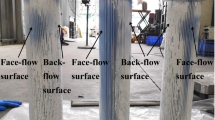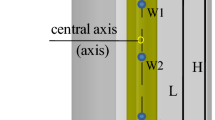Abstract
The operation range of the pressure drop between the peak and the base line during the pulse-jet cleaning of a ceramic filter relates closely with the grouping number of the filter elements in the filter unit, as well as the design and the operation conditions of the pulse cleaning system. A semi-empirical model was developed to predict the pressure drop of the filter unit versus the operation time according to the grouping numbers of the total filter elements in this study. The model is based on theoretical considerations and the application of the experimental data to develop a simple equation, which should be useful for preliminary design and operational inspection. The semi-empirical formula predicts the operational values of the pressure drop between the peak and the base line, which suggests the guideline for grouping of the filter elements for the pulse-jet cleaning. Peak pressure drop decreases gradually and then finally approaches a minimum stable value as the number of the cleaning group increases. Otherwise, the base line pressure drop increases gradually and then finally approaches a maximum stable value as the number of the cleaning group increases. Thus, the gaps between the peak and the base line pressure drop become narrow as the number of cleaning group increases. This phenomenon of gap reduction is desirable for the pulse cleaning of the filter element as it reduces the pulse cleaning load. Moreover, pulse cleaning becomes more effective as the number of the cleaning groups increases.
Similar content being viewed by others
References
J. P. K. Seville, S. Ivatt and G. K. Burnard, High Temperature Gas Cleaning, Ed. by E. Schmidt et al., University of Karlsruhe, 23 (1996).
S. Heidenreich, Fuel, 104, 83 (2013).
B. Dou, C. Wang, H. Chen, Y. Song, B. Xie, Y. Xu and C. Tan, Chem. Eng. Res. Design, 90, 1901 (2012).
K. Schulz and M. Durst, Filtration and Separation, 31 (1), 25 (1994).
H. Chi, L. Yu, J. H. Choi and Z. Ji, Chinese J. Chem. Eng., 16 (2), 306 (2008).
Z. Ji, M. Shi and D. Fuxin, Powder Technol., 139, 200 (2004).
I. Schildermans, J. Baeyens and K. Smolders, Filtration and Separation, 41 (5), 26 (2004).
A. R. Mazaheri and G. Ahmadi, Adv. Powder Technol., 17 (6), 623 (2006).
Z. Ji, S. Peng and L. Tan, Chinese J. Chem. Eng., 11 (6), 626 (2003).
G. Ahmadi and D. H. Smith, Aerosol Sci. Technol., 36, 665 (2002).
J. H. Choi, Y. G. Seo and J. H. Chung, Powder Technol., 114, 129 (2001).
S. K. Grannell and J. P. K. Seville, Proceedings of the 4th International Symposium on Gas Cleaning at High Temperatures, A. Dittler, et al. Ed., Karlsruhe, Germany, 96 (1999).
D. H. Smith, V. Powell and G. E. I. Ahmadi, Powder Technol., 94, 15 (1997).
X. Simon, S. Chazelet, D. Thomas, D. Bemer and R. Regnier, Powder Technol., 172, 67 (2007).
J. H. Choi and G. Park, Energy Eng. J., 8 (1), 143 (1999).
J. H. Choi, S. J. Ha and Y. O. Park, Korean J. Chem. Eng., 19 (4), 711 (2002).
J. H. Choi, S. J. Ha, Y. C. Bak and Y. O. Park, Korean J. Chem. Eng., 19 (6), 1085 (2002).
J. H. Choi, Y. C. Bak, H. J. Jang, J. H. Kim and J. H. Kim, Korean J. Chem. Eng., 21 (3), 726 (2004).
Y. Endo, D.-R. Chen and D. Y. H. Pui, Powder Technol., 98, 241 (1998).
J. H. Choi, S. J. Ha and H. J. Jang, Powder Technol., 140, 106 (2004).
A. Gupta, V. J. Novick, P. Bisawas and P. R. Monson, Aerosol Sci. Technol., 19, 94 (1993).
R. Dennis and J. A. Dirgo, Filtration and Separation, 18, 394 (1981).
C. R. N. Silva, V. S. Negrini, J. R. Aguiar and M. L. Coury, Powder Technol., 101, 165 (1999).
J. H. Kim, Y. Liang, K. M. Sakong, J. H. Choi and Y. C. Bak, Powder Technol., 181, 67 (2008).
M. L. Aguiar and J. R. Coury, Ind. Eng. Chem. Res., 35, 3673 (1996).
M. lupion, B. Alonso-Farinas, M. Rodriguez-Galan and B. Navarrete, Chem. Eng. Processing, 66, 12 (2013).
Author information
Authors and Affiliations
Corresponding author
Rights and permissions
About this article
Cite this article
Kim, JH., Kim, YC. & Choi, JH. Characteristics of pressure drop during the pulse-jet cleaning of a ceramic filter for high temperature and high pressure. Korean J. Chem. Eng. 33, 726–734 (2016). https://doi.org/10.1007/s11814-015-0211-y
Received:
Accepted:
Published:
Issue Date:
DOI: https://doi.org/10.1007/s11814-015-0211-y




